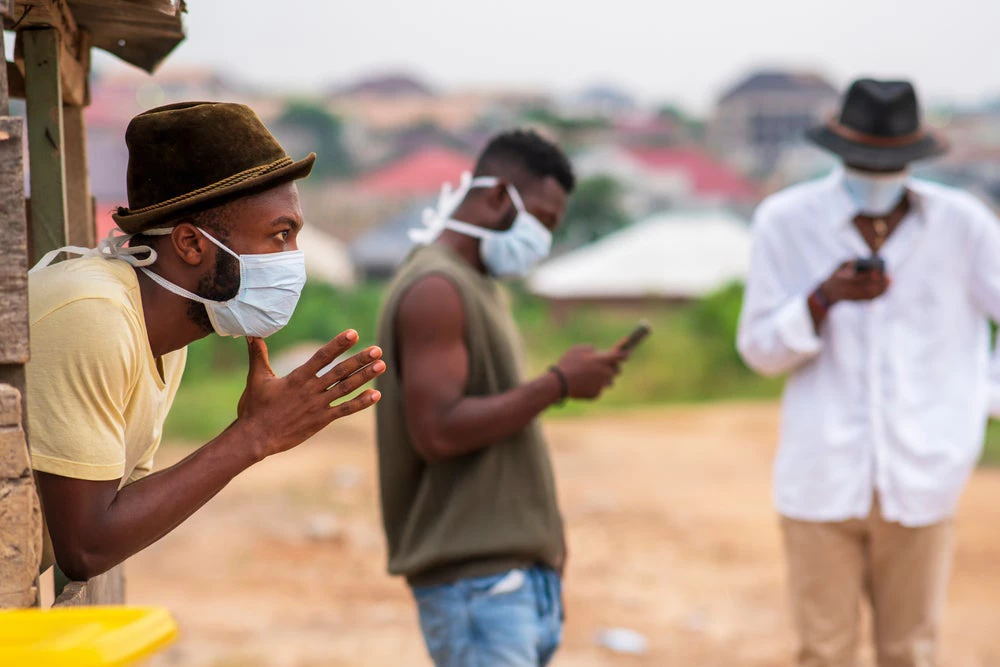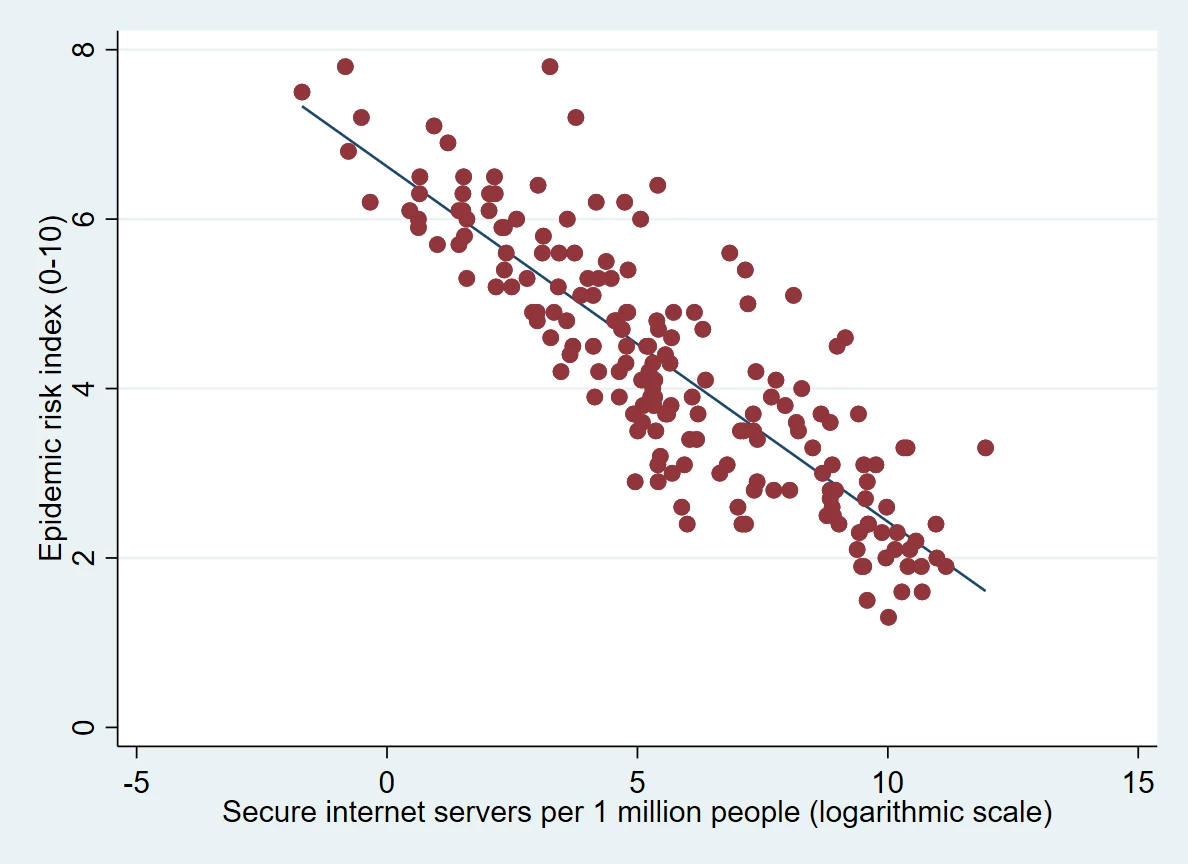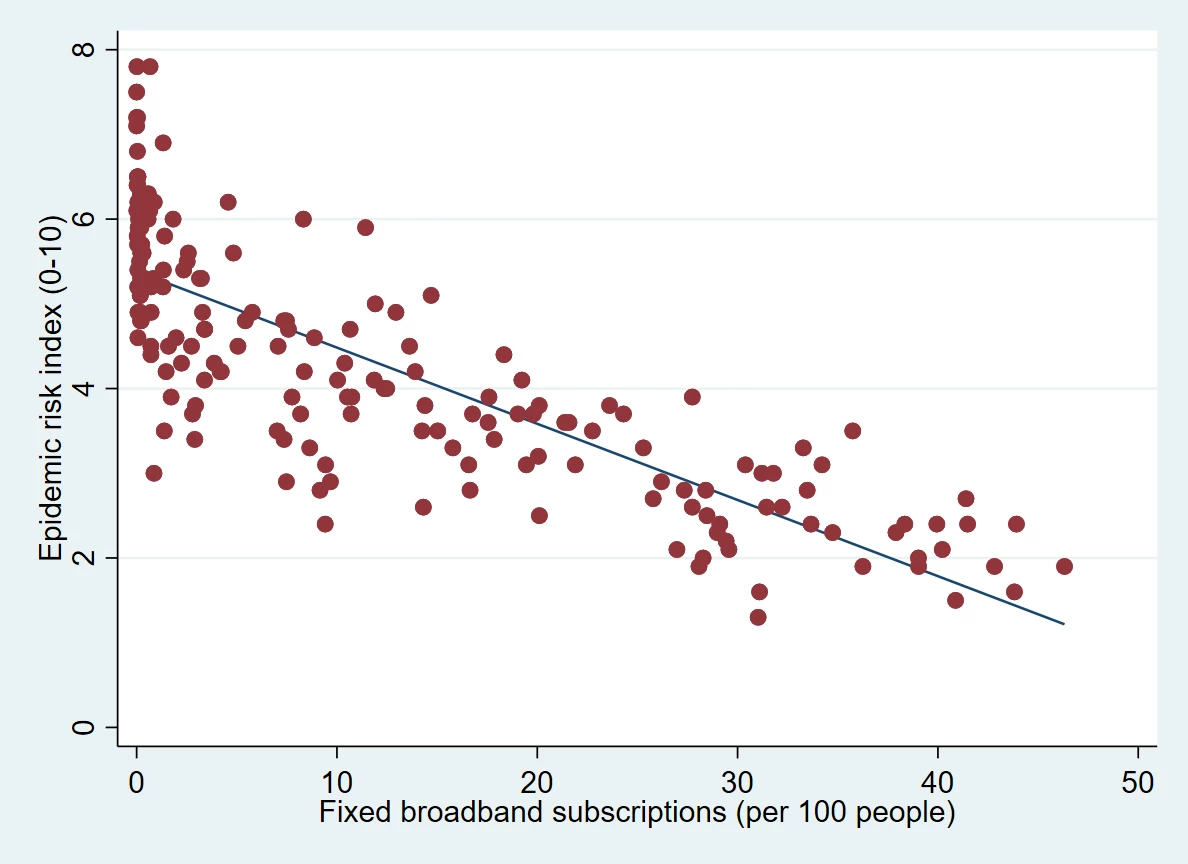 Photo: Yaw Niel/Shutterstock
Photo: Yaw Niel/Shutterstock
Over the past few months, we have seen how digital technology helps in the fight against COVID-19 (coronavirus). Several recent blogs discussed how expanding digital services can help alleviate the impact of COVID-19 on the economy now and boost the growth later (here, here and here). We will show that digitalized economies have lower epidemic risks and explain some channels through which risks can be mitigated. Moreover, digital development can help Africa fight the virus as COVID-19 begins to take hold in the continent.
Using cross-sectional data on internet usage and epidemic risk for 180 economies, we show that countries with wider internet access and safer internet servers tend to be more resilient to epidemics such as COVID-19 (figure 1). For this analysis, the European Commission’s Epidemic Risk Index is used to assess the risk of countries to epidemic outbreak that could exceed the national capacity on three dimensions: the exposure to infectious agents, the vulnerability of the exposed population and the lack of coping capacity. Countries with wider internet access and safer internet servers tend to have better infrastructure (such as energy and transport), stronger governance and human development (such as health, nutrition and social protection) to cope with pandemics. Additionally, digital technology can help flatten the curve through various channels as follows.
Figure 1. Safer internet servers and wider internet access are strongly correlated with lower risk for epidemics
Source: World Bank Group’s World Development Indicators; European Commission’s Joint Research Center.
Note: The graph on the left includes 183 economies and the graph on the right includes 181 economies, where data are available in both databases. Both relationships are significant at the 1% level when controlling for income per capita.
First, through digital platforms, authorities can provide official, trustworthy and timely information and advice about COVID-19. Of the 193 United Nations member states, 167 countries provided information on their national portals, mobile apps or through social media platforms that covers outbreak statistics, travel restrictions, practical guidance on protection and governmental responses. Reliable information from the governments helps people make informed decisions about their daily routines and build public trust. In the United Kingdom, the government launched an automated chatbot service on WhatsApp that allowed the public to get answers to the most common questions about COVID-19 directly from the government.
Second, online platforms connect millions of students and workers to their schools and offices from home during the closures to contain the spread of COVID-19. In China, Colombia, Italy, Jordan, South Korea, Spain, Uganda and the United States, educators embraced online learning and held live-streaming classes through digital platforms such as Alibaba’s DingTalk, Google Hangouts, Kolibri and Microsoft Teams. Around the globe, businesses are bringing their teams together face-to-face with video conferencing and screen sharing on electronic devices through digital platforms.
Third, digital data and artificial intelligence (AI) can help diagnose and monitor the infectious virus. In South Korea, an artificial intelligence firm released free COVID-19 analysis software for early diagnosis and assessment of virus symptoms. The software can detect, segment and produce 3D models of lung damage caused by COVID-19 based on analysis of CT images. The country also used contact tracing in combating the coronavirus outbreak through mobile technologies such as GPS, cellphone masts and AI-powered big data analytics to help the government understand and manage the spread of COVID-19 within their communities.
Digital development helps fight COVID-19 in Africa
Some African governments use digital platforms to launch COVID-19 information services and debunk misinformation. In South Africa, the national health department set up a WhatsApp service to provide information to locals, from symptoms, prevention tips and testing information. Importantly, the service also dispels false claims about cures, from eating garlic and beetroot to taking hot water baths and sensitizes to scammers looking to take advantage of people’s fears. In Nigeria, health authorities partnered with Facebook to send push notifications to users with information on symptoms and how to avoid infection, and with Twitter to elevate medical information from authoritative sources.
Other countries leverage mobile money to curb the spread of COVID-19. One fifth of African adults use mobile cash services (figure 2). In Kenya, Safaricom, the country’s largest telecom company, implemented a fee-waiver on East Africa’s leading mobile-money product, M-Pesa, to reduce the physical exchange of currency. The move followed the directive by President Uhuru Kenyatta to “explore ways of deepening mobile money usage to reduce the risk of spreading the virus through the physical handling of cash”. Similar measures designed to reduce the risk of COVID-19 transmission through mobile money were adopted in Ghana, Nigeria and Uganda. In Togo, the government digitized social payments to transfer mobile cash to informal workers whose incomes are disrupted by COVID-19.
Figure 2. One in five people in Sub-Saharan Africa use a mobile money account
Mobile money account (% age 15+), 2017
Source: World Bank Group’s Global Financial Inclusion Index.
In addition, digital agriculture lays the foundation for initiatives to alleviate the COVID-19’s impact on food security. The recent Africa’s Pulse report by the World Bank Group found that COVID-19 is risking Africa’s food security due to trade disruptions, lower agricultural productions and fewer food imports. The progress made in digital agriculture in Africa over the years can help secure essential farm operations, keep food supply chains moving, and reach vulnerable populations. In Kenya, FarmIT provides farmers with agronomic support, market linkages and an e-commerce solution. Africa’s leading platforms such as Mkulima Young and G-Soko connect farmers to suppliers and distributors, and Zambia-based eMsika supports wholesale and retail trade in agricultural products.
According to Doing Business, a World Bank Group flagship publication, the widespread use of electronic systems is associated with more business-friendly regulations, a conduit for business creation and poverty reduction. This is especially important for Sub-Saharan Africa as COVID-19 threatens to drive the region into its first recession in 25 years and push millions into extreme poverty. All 20 economies that topped the global ranking in Doing Business 2020 have online business incorporation processes, electronic tax-filing platforms and online procedures related to property transfers. In contrast, only one out of 48 Sub-Saharan African countries have all these digital systems, partly because the continent is still catching up on its internet data access (figure 3).
Source: World Bank Group’s World Development Indicators.
The world will increasingly rely on digital technology to help us weather the COVID-19 storm. Digital platforms help build more resilient societies to the pandemic, as people can now access official information, enroll in e-courses, take online jobs, send mobile money and even receive telemedicine—no matter where they live.







Join the Conversation